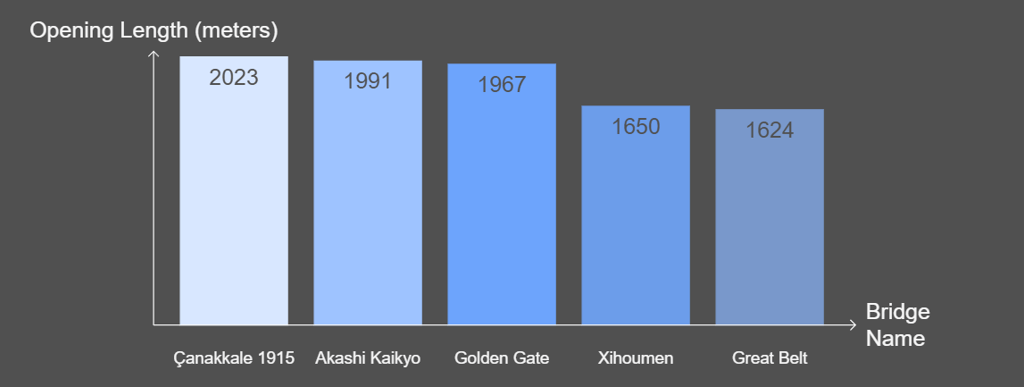
Suspended Bridges: Engineering Masterpieces Facing Nature's Challenges
How did these towering structures manage to withstand the force of strong winds, the weight of enormous vehicles, and sudden earthquakes? They are not just crossings that connect two banks or a bridge spanning a valley
Construct Vision Team
12/27/202411 min read
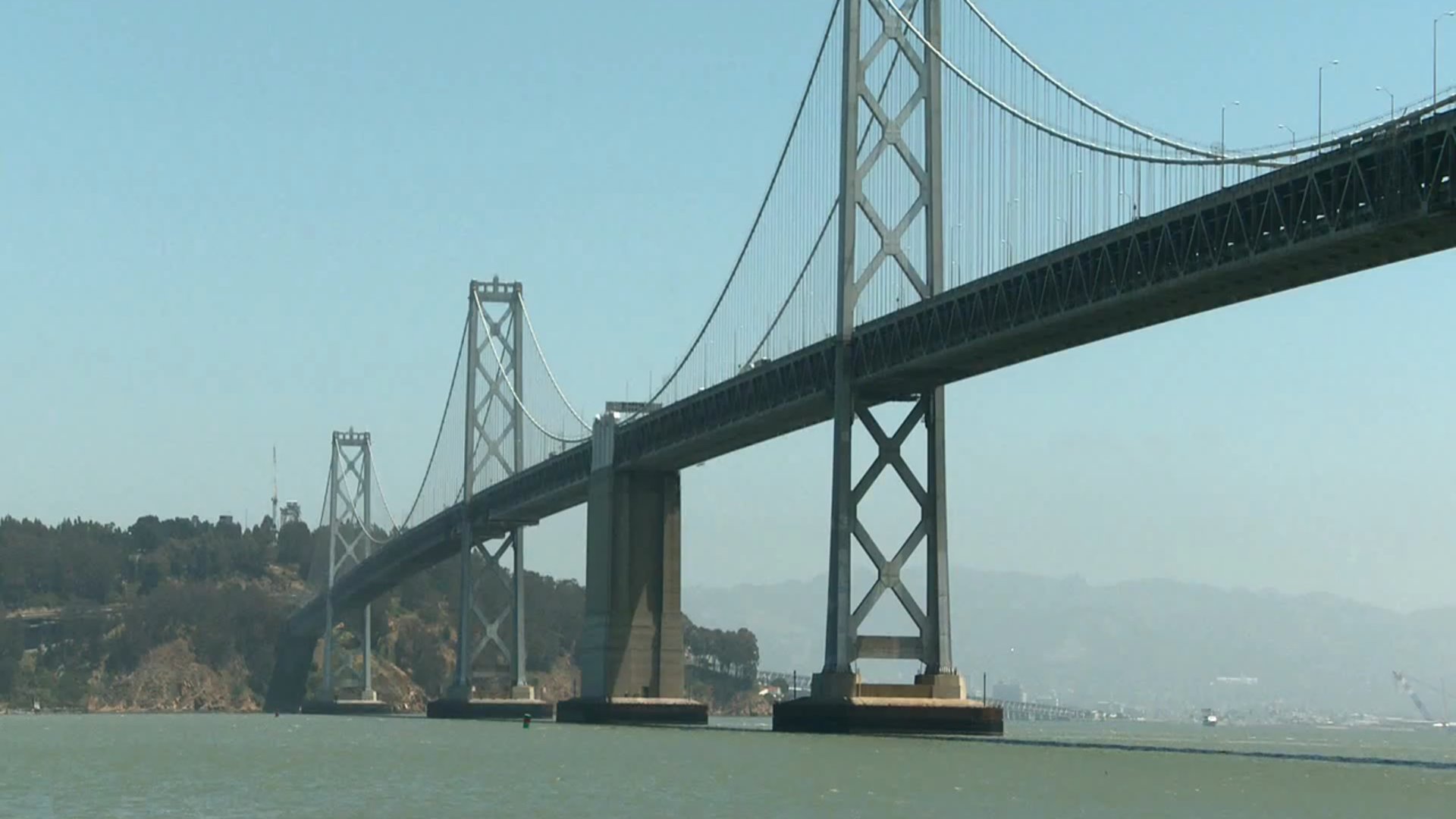
Imagine yourself standing on a suspension bridge, with massive steel cables stretching beneath your feet, and the wind rushing around you, carrying the sounds of nature. How have these towering structures managed to withstand the force of fierce winds, the immense weight of vehicles, and the sudden earthquakes of the earth? They are not just crossings that connect two banks or a bridge that spans a valley; they are a testament to the genius of civil engineering that dares to challenge the laws of nature.
Since man first realized the need to connect impossible places, suspension bridges emerged as a creative solution, overcoming geographical obstacles to tell stories of creativity and determination. In this article, we will dive into the world of suspension bridges, to uncover their secrets, how they have become symbols of engineering creativity, and why they remain steadfast in the face of the harshest natural challenges."
History, Benefits, and Criticisms of Suspension Bridges:
Suspension bridges are an ancient engineering achievement, with a history that dates back to ancient times. It is difficult to determine the oldest suspension bridge conclusively due to the age of the idea and the deterioration of building materials over time, but there is ample historical evidence suggesting that ancient civilizations built simple bridges made of ropes and natural fibers across rivers and valleys.
Ancient civilizations in Asia and Europe used simple bridges for crossing, and it is believed that the Chinese were pioneers in building suspension bridges, using bamboo and strong ropes to construct long bridges over deep rivers.
As civilizations evolved and technology advanced, suspension bridges developed significantly, becoming one of the most important symbols of engineering and civil progress. Today, there are numerous suspension bridges around the world, distributed across many countries, especially in developed and industrialized nations.
Suspension Bridges: A Solution to Many Challenges
Suspension bridges have solved the problem of crossing natural barriers such as rivers, valleys, and straits, facilitating movement between regions and boosting trade and tourism. They have connected remote areas to cities and vital centers, which was one of the main reasons for developing these areas and improving the living standards of their inhabitants. Suspension bridges have also contributed to enhancing the economic development of the areas they serve by facilitating the transportation of goods and commodities.
However, suspension bridges are considered to be extremely costly infrastructure projects, which leads some people to question their feasibility. They may also impact the surrounding environment, especially if they are located in environmentally sensitive areas. Additionally, suspension bridges require costly periodic maintenance to ensure their safety and effectiveness.
We can say that despite the criticisms directed at suspension bridges, their benefits far outweigh their cost and side effects. They represent a long-term investment that contributes to the economic and social development of communities. Modern technological developments have also helped reduce the environmental and construction costs of suspension bridges, making them a more sustainable option.
Therefore, suspension bridges are a unique engineering achievement that has changed the face of the world and made life easier for millions. Despite the challenges they face, they remain one of the most important infrastructure projects that contribute to the progress and development of nations."
The Role of Suspension Bridges in Wars and Natural Disasters
Suspension bridges have played a crucial role in many historical events, including wars and natural disasters:
• Wars:
Suspension bridges were used as vital supply lines for armies, allowing the transportation of troops, provisions, and supplies across rivers and valleys. Sometimes, they were used as military obstacles, where they were destroyed to prevent the enemy's advance. Often, after a war victory, suspension bridges were built as a symbol of triumph and control over the region.
• Natural Disasters:
Following natural disasters such as earthquakes and floods, suspension bridges were used as evacuation routes and to allow aid to reach affected areas. They also help reconnect affected areas to the outside world, accelerating the relief and reconstruction process.
Suspension bridges have always been associated with strength and resilience in the minds of people, and there are several reasons for this:
Engineering Challenge: Building a suspension bridge requires high engineering skills, as the bridge must be able to withstand a large weight and immense natural forces such as wind and earthquakes.
Natural Challenge: Suspension bridges are often built in challenging areas, such as deep valleys and mountainous regions, which increases the difficulty of their construction.
Symbolism: Suspension bridges symbolize challenge and overcoming difficulties, as they connect seemingly separate places and allow the passage of people and goods."
The Longest Suspension Bridge in the World Today: The Çanakkale 1915 Bridge:
The Çanakkale 1915 Bridge - Turkey currently holds the title of the longest suspension bridge in the world. This majestic bridge spans the Dardanelles Strait, connecting the continents of Asia and Europe, making it a prominent engineering landmark.
The Çanakkale 1915 Bridge has a total length of approximately 4608 meters, surpassing many other suspension bridges around the world. Its longest span between bridge piers is approximately 2023 meters, which is the reason for its world record. The bridge stretches over an immense distance above the Dardanelles Strait.
The structural design and construction of the bridge utilized the latest technologies, enabling the achievement of this immense length. The bridge serves a strategic purpose, shortening the distance and travel time between the two sides of Turkey, and enhancing the economic development of the region. The Dardanelles Strait is located in a strategic position connecting the Black Sea and the Aegean Sea, making it a vital waterway for trade and transportation. The strait holds significant historical importance, having witnessed numerous wars and battles, and being a strategic location in many civilizations. The bridge is an attractive tourist landmark, representing the latest achievements in civil engineering, and a symbol of technological and engineering progress in Turkey.
Naming Explanation: Although the bridge was built in the 21st century, its name "Çanakkale 1915" carries important historical and symbolic connotations. The number 1915 in the bridge's name refers to the Battle of Gallipoli, which took place in 1915, where the Ottoman forces achieved an important victory over the British and French naval forces. Thus, this number is considered an honor to Turkish military history and a symbol of national pride. It can be said that the purpose of this name is to link the modern bridge to this important historical event, affirming the continuity and development of Turkish civilization. It also enhances national identity and connects citizens to their history, in addition to tourism marketing.
Comparison with Other Bridges:
Before the construction of the Çanakkale 1915 Bridge, the title of the longest suspension bridge in the world belonged to the Akashi Kaikyo Bridge in Japan, also known as the Pearl Bridge.
With the continuous development in engineering and technology, we can expect to witness the construction of even longer and more advanced suspension bridges in the future. However, the Çanakkale 1915 Bridge will remain a prominent landmark in the history of civil engineering, and will maintain its position as the longest suspension bridge in the world for at least the coming years.
Share the post
Akashi Kaikyo Bridge: A Jewel of Japanese Civil Engineering
The Akashi Kaikyo Bridge, also known as the Pearl Bridge, is one of the longest suspension bridges in the world, located in Japan. This bridge connects the cities of Kobe and Awaji, spanning over the Akashi Strait. It is renowned for its majestic beauty and stunning architectural design, making it one of the most important tourist attractions in Japan.
The construction was completed in 1998 and officially opened in 1999. This was after a maritime disaster in the strait that led to the death of a large number of people. The purpose of building the bridge was to provide a safe and rapid means of transportation between the two islands, and to improve economic communication between them.
The longest span between bridge piers is approximately 1991 meters, making it the second-longest suspension bridge in the world. The total length of the bridge is approximately 3911 meters, and the height of the bridge towers is approximately 297 meters above the water surface, making them among the highest towers in the world. The bridge is characterized by its beautiful night lighting, making it appear like a pearl bracelet shining in the dark.
The bridge was designed to withstand strong earthquakes of up to 8.5 magnitude, as well as strong typhoons, using the latest technologies in civil engineering. It was also designed to be environmentally friendly.
The bridge is a symbol of technological progress in Japan, and a testament to the ability of Japanese engineers to achieve massive engineering achievements. It is also one of the most important tourist attractions in Japan.
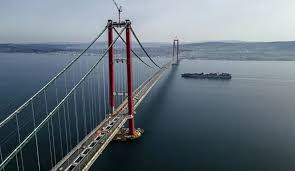

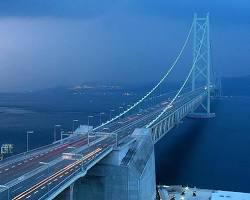

Golden Gate Bridge:
The Golden Gate Bridge in San Francisco, United States, is one of the most famous suspension bridges in the world, and is an iconic landmark of San Francisco. This bridge is distinguished by its unique design and distinctive orange color, making it a prominent landmark in the region.
The basic idea behind its design was to connect the San Francisco Peninsula with Marin County, and to provide a practical solution to overcome the geographical and natural challenges of the Golden Gate Strait, such as strong currents and fierce winds.
Beauty and functionality were combined in the bridge's design, bringing together strength and artistic beauty. The orange color of the Golden Gate Bridge was chosen to be visible in the dense fog that covers the area frequently throughout the year. The bridge was designed to integrate with its surrounding environment, making it an integral part of the natural landscape.
The bridge's deck is characterized by its large width, allowing for the passage of six vehicle lanes, in addition to lanes for pedestrians and cyclists.
The Golden Gate Bridge has become a symbol of the city of San Francisco. The bridge attracts millions of visitors annually, contributing to the activation of the local economy. It is an engineering achievement, as it was considered one of the longest suspension bridges in the world at the time of its construction.
This bridge was not without criticism at the time of its construction. Some considered the cost of its construction to be extremely high, and that there were alternative solutions that were less costly. Others criticized the orange color of the bridge, considering it unconventional and inappropriate.
The construction of the Golden Gate Bridge was officially completed on May 27, 1937, which was the day called "Pedestrian Day," after more than four and a half years of hard work and challenges.
The total length of the bridge is approximately 2737 meters. The longest span between bridge piers is approximately 1967 meters.
The Dardanelles, Golden Gate, and Akashi Kaikyo Bridges are masterpieces of civil engineering, and share many features, such as the use of steel and concrete in construction, and overcoming major engineering challenges. However, each bridge differs from the others in its design, history, and cultural significance. There are many examples of suspension bridges, such as:
Xihoumen Bridge:
This bridge is located in China, and is one of the longest suspension bridges in the world. It is distinguished by its advanced engineering design and its ability to withstand high loads.
Total length: 4694 meters, longest span: 1650 meters, opened in 2009.

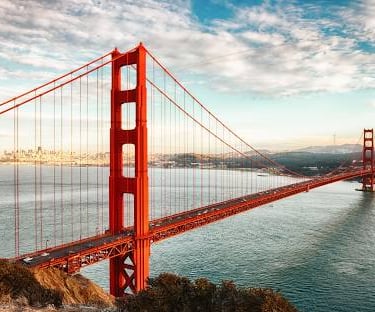
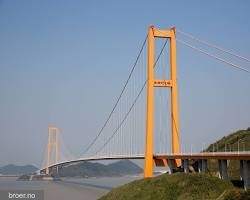

Great Belt Bridge:
This bridge is located in Denmark, and connects the islands of Zealand and Funen. It is distinguished by its elegant design and breathtaking views of the sea.
Total length: 6790 meters, longest span: 1624 meters, opened in 1997. It is one of the longest suspension bridges in the world.
The name "Great Belt" is derived from the strait that the bridge spans, which bears the same name. This strait is one of the most important waterways in the region, and represents a belt connecting the Baltic Sea and the Kattegat Bay.
Historically, this strait was used as an important maritime passage for trade and sea transportation. It was named the "Great Belt" due to its large width, shape, and strategic importance. The bridge that spans this strait acts as a belt connecting the two islands, just as a belt is part of the body.
These bridges are considered masterpieces of civil engineering, and share many features, such as the use of steel and concrete in construction, and overcoming major engineering challenges. However, each bridge differs from the others in its design, history, and cultural significance."
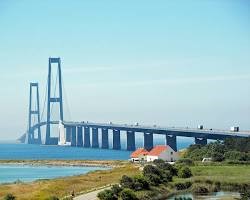

The World of Engineering and Construction Continues to Evolve, and Longer Suspension Bridges May Be Built in the Future.
Note: When comparing suspension bridges, the focus is on the length of the main span between the towers, rather than the total length of the bridge.
Now, let's delve into the technologies that measure the resistance of bridges to wind, earthquakes, and various loads, which are an essential part of the design and maintenance process of suspension bridges. Here are the most prominent of these technologies and how they are used to face the challenges of building suspension bridges and ensure safety and efficiency:
1- Measuring the Resistance of Bridges to Wind:
a. Wind Tunnel Testing: A miniature model of the bridge is designed and tested in a wind tunnel to simulate the effect of wind at different speeds and directions. This is done to identify weak points and develop the bridge design to resist vibrations resulting from the wind.
b. Anemometers: These devices are installed on the bridge to continuously measure wind speed and direction. For example, the Hong Kong-Zhuhai-Macao Bridge uses a network of sensors to monitor the wind.
c. Computational Fluid Dynamics (CFD): Advanced computer programs are used to simulate the flow of wind around the bridge structure.
2- Resistance of Bridges to Earthquakes:
a. Seismic Simulation: The structural elements of the bridge are tested on giant shaking platforms that simulate earthquake vibrations.
b. Structural Dampers: Devices are added to bridges to reduce the vibrational effects resulting from earthquakes. Some common types include:
- Tuned Mass Dampers: These dampers are primarily composed of a large mass connected to the structure through a spring and damper system. When the building is subjected to vibration, the mass begins to move in the opposite direction of the building's vibration, absorbing a large portion of the energy. The dampers reduce the amplitude and duration of the vibration, reducing the stress on the structure.
- Viscous Energy Dissipators: These dampers are based on the simple principle of converting the kinetic energy resulting from vibrations into heat that is dissipated. This is done by using viscous materials that resist movement, so when the structure is subjected to vibration, these viscous materials resist the movement, leading to the generation of heat and the dissipation of energy.
c. Seismic Sensors: These are installed on structures to monitor seismic activity in real-time.
3- Resistance of Bridges to Various Loads:
a. Static Load Testing: The bridge is loaded with heavy weights (such as filled trucks) to test its load-bearing capacity.
b. Dynamic Load Testing: The bridge is tested using devices that simulate the effect of dynamic movement (such as the passage of vehicles at high speeds).
c. Load Sensors: These are installed under the bridge's surface to continuously measure the actual weights the bridge bears, to detect any excessive weights or structural stress early on.
d. 3D Structural Analysis: Advanced analysis programs are used to analyze the distribution of loads on the bridge structure to improve the design and reduce risks.
4- Advanced and Innovative Technologies:
a. Smart Monitoring Systems: Networks of sensors are used to measure stress, vibration, and thermal changes around the clock. For example, the Golden Gate Bridge uses a smart monitoring system consisting of hundreds of sensors.
b. Drones: These are used to periodically inspect structures, especially in hard-to-reach areas, to detect corrosion or damage without disrupting traffic.
c. 3D Printing Technology: This is used to print miniature models or components that are tested before implementation, to ensure performance before actual construction begins.
Modern construction technologies not only contribute to ensuring the safety of bridges, but also enhance their efficiency in the long term. Thanks to these tools, suspension bridges have become more capable of resisting natural and environmental challenges, making them true symbols of engineering creativity.
Suspension Bridges: A Dialogue Between Man and Nature
Suspension bridges are not just engineering structures that connect two banks, but they are symbols of human creativity that challenge the impossible. These engineering masterpieces show how technology and innovation can challenge natural conditions and make the impossible possible.
With the continuous progress in digital design technologies and smart materials, the question remains: How will the bridges of the future look? Can they become self-repairing? Or even fully adaptable to weather and environmental conditions?
This brief tour invites you to explore this amazing world and search for the ways in which architects and engineers can develop more efficient and sustainable structures. What is your idea for a bridge that could be a wonder of the future? Share your vision with us!
A quick comparison between the examples mentioned:
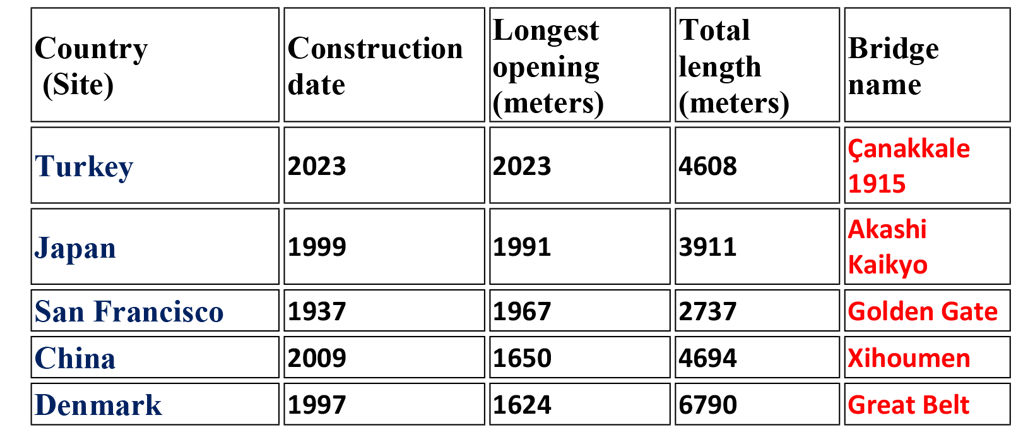

Thank you
Construct Vision Team
